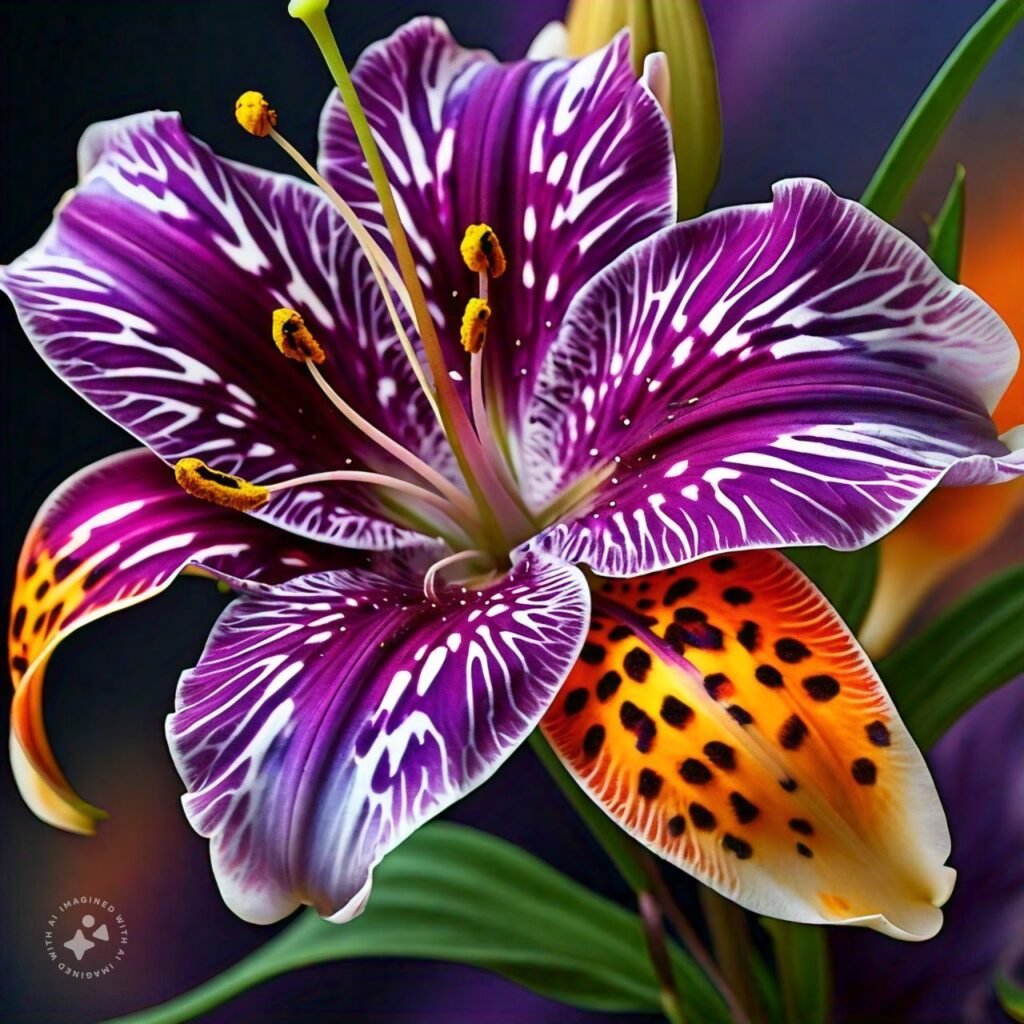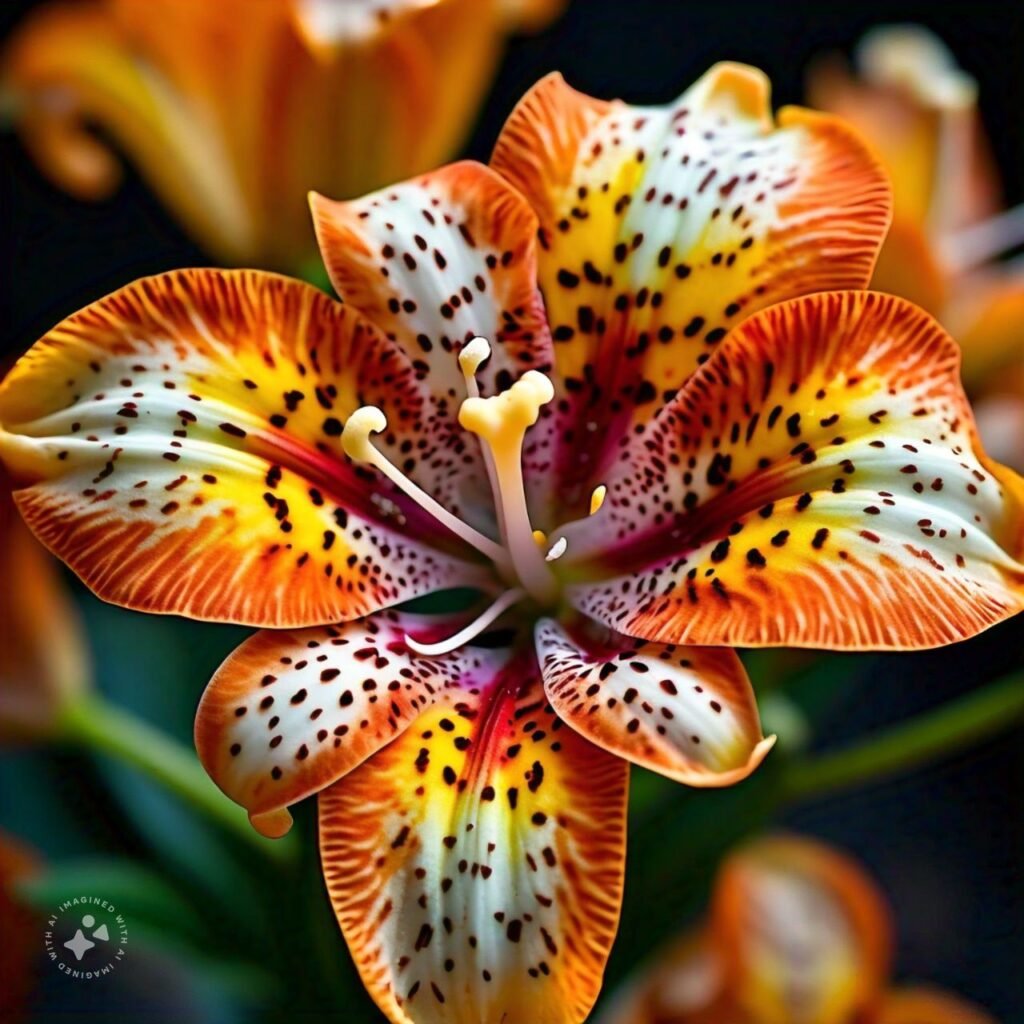United States

The Leopard Lily is native to the western United States, particularly in California, Oregon, and Washington. It thrives in moist, mountainous regions and along stream banks.
Native American tribes in California have historically valued the Leopard Lily for its beauty and as a medicinal plant. Some tribes used the bulbs for food.
The plant is considered a symbol of natural beauty in the Pacific Northwest and has been a subject of conservation efforts due to habitat loss.
Canada
In Canada, the Leopard Lily can be found primarily in British Columbia, especially in the southwestern part near the U.S. border.
It plays a role in local ecosystems by providing nectar for pollinators, including butterflies and bees.
The Leopard Lily is not as widespread in Canada, making it somewhat rare and subject to conservation attention in certain areas.

United Kingdom

The Leopard Lily was introduced to the United Kingdom as an ornamental plant in gardens and estates during the Victorian era.
It became popular in British horticulture due to its striking appearance. The plant is often used in decorative gardening and has been featured in botanical collections.
Today, it is still cultivated in the UK, especially in areas with well-drained soil and ample sunlight. It’s considered a hardy plant suitable for temperate gardens.
Germany
The Leopard Lily was introduced to Germany for ornamental purposes. It is cultivated in private gardens, botanical gardens, and sometimes in public parks.
German botanists and horticulturists have shown interest in the Leopard Lily due to its vibrant colors and the ease with which it can be hybridized with other lilies.
Australia
The Leopard Lily was introduced to Australia as an ornamental garden plant.
It is cultivated in temperate regions of Australia, particularly in areas with conditions similar to its native habitats, such as the cooler, moist environments of Victoria and New South Wales.
The Leopard Lily has adapted well to Australian gardens, though it is not considered invasive.
Japan
In Japan, where lilies are highly regarded, the Leopard Lily has been of interest to horticulturists for its distinctive appearance.
It is cultivated primarily in botanical gardens and by lily enthusiasts. Its bright colors and unique patterns make it a subject of hybridization experiments.
China
The Leopard Lily is known and cultivated in China as part of the broader interest in ornamental lilies.
Although not native, it is appreciated for its beauty and is sometimes featured in gardens and botanical collections.
South Korea
Similar to Japan, South Korea has a strong horticultural tradition, and the Leopard Lily is cultivated in gardens and botanical collections.
The plant is valued for its ornamental qualities and is part of the diverse array of lilies grown in the country.
France
The Leopard Lily was introduced to France as part of the broader European interest in exotic plants during the 19th century.
It is grown in gardens, particularly in regions with a suitable climate, such as the southern parts of the country. The plant is appreciated for its striking appearance in floral displays.
Italy
The Leopard Lily was introduced to Italy as an ornamental plant and has been cultivated in private and public gardens.
It is valued for its beauty and is often included in garden designs that emphasize Mediterranean aesthetics.

Scientific Name: Leopard Lily is scientifically known as Lilium pardalinum. It’s a species native to western North America, particularly California. The name “pardalinum” means “leopard-like,” referring to the plant’s vibrant orange-red flowers with dark spots resembling a leopard’s coat.

Habitat: Leopard Lilies thrive in moist habitats, often found along streams, rivers, and in wet meadows. They prefer partial shade but can tolerate full sun, especially in cooler climates. These plants are commonly found at elevations ranging from sea level to 6,000 feet.
Flowering Season: The Leopard Lily typically blooms in mid to late summer, from June to August. Its striking flowers are a vibrant orange-red with dark spots, which are pollinated by hummingbirds and bees. The blooms are usually 2 to 3 inches wide.
Growth Habit: Leopard Lilies grow from bulbs, which can be divided to propa
gate new plants. They can reach heights of 3 to 6 feet, making them a striking addition to any garden. Their tall, slender stems are topped with clusters of downward-facing flowers.
Toxicity: Leopard Lilies are toxic to cats, causing symptoms like vomiting, lethargy, and kidney failure if ingested. Pet owners should be cautious about having these plants in areas accessible to cats. Interestingly, they are not toxic to humans or dogs.
Cultural Significance: In Native American culture, the Leopard Lily was used for medicinal purposes and as a food source. The bulbs were often cooked or dried and ground into flour. The plant also held symbolic meanings, often representing resilience and beauty.

Propagation: Leopard Lilies can be propagated through division of bulbs or by seed. The seeds require a period of cold stratification to germinate. Once established, they can naturalize and spread in suitable conditions, creating dense, colorful colonies.

Pest Resistance: Leopard Lilies are relatively pest-resistant. However, they can be affected by aphids, slugs, and lily beetles. Regular monitoring and organic pest control methods, like neem oil, can help keep these pests at bay.
Soil Preference: These lilies prefer rich, well-drained soil with a slightly acidic to neutral pH. Adding organic matter like compost can improve soil quality and provide the nutrients needed for healthy growth. They also benefit from a layer of mulch to retain moisture.
Watering Needs: Leopard Lilies require consistent moisture, especially during their growing and blooming seasons. They do not tolerate drought well, and their roots should never be allowed to dry out completely. However, they also need good drainage to prevent bulb rot.
Sunlight Requirements: Leopard Lilies thrive in partial shade but can adapt to full sun in cooler climates. In hotter areas, some afternoon shade is beneficial to prevent the flowers from fading and the plant from becoming stressed due to excessive heat.
Companion Plants: Leopard Lilies pair well with other moisture-loving plants like ferns, hostas, and astilbes. These companions can help create a lush, woodland garden feel and provide the contrasting foliage and textures that highlight the lily’s vibrant flowers.
Wildlife Attraction: The vibrant flowers of the Leopard Lily attract hummingbirds, bees, and butterflies, making them an excellent choice for pollinator-friendly gardens. The nectar-rich blooms provide essential food sources for these pollinators during the summer months.
Historical Use: The Miwok people of California traditionally used Leopard Lily bulbs as a food source. The bulbs were roasted or boiled, similar to potatoes. They were also used in trade, showcasing the plant’s importance in indigenous culture and economy.

Varieties: There are several recognized varieties of Leopard Lily, including Lilium pardalinum ssp. vollmeri, which is known for its larger flowers and taller stature. Each variety has subtle differences in flower color, size, and habitat preference.

Seed Dispersal: Leopard Lilies have evolved to use water as a medium for seed dispersal. After flowering, the plant produces capsules that release seeds into nearby water sources. These seeds then travel downstream, allowing the plant to colonize new areas.
Winter Hardiness: Leopard Lilies are hardy in USDA zones 5-9. In colder climates, the bulbs can survive winter if mulched properly. In warmer zones, they may need protection from excessive summer heat, which can cause dormancy or reduce flower production.
Cultural Symbolism: In the language of flowers, lilies often symbolize purity, beauty, and renewal. The Leopard Lily, with its striking appearance and resilience, can also symbolize perseverance and the ability to thrive in challenging conditions.
Garden Design: Leopard Lilies are often used in naturalistic garden designs, where they can mimic their wild habitat. They add height and drama to mixed borders, and their colorful blooms create focal points in woodland gardens or along stream edges.
Sustainability: Leopard Lilies are considered a sustainable choice for gardens in their native range, requiring minimal fertilizers and pesticides. They also play a role in preserving local biodiversity by providing food and habitat for native pollinators.
Medicinal Uses: Some Native American tribes used Leopard Lily roots for medicinal purposes, particularly to treat respiratory ailments and wounds. While not widely used in modern herbal medicine, these traditional practices highlight the plant’s historical importance.
Drought Response: In times of drought, Leopard Lilies may enter a state of dormancy to conserve energy. The plant’s bulb acts as a storage organ, allowing it to survive until favorable conditions return. This adaptation makes them resilient to varying environmental conditions.

Hybridization: Leopard Lilies have been hybridized with other lily species to create new cultivars with enhanced colors, sizes, and blooming periods. These hybrids often retain the hardiness and vigor of the Leopard Lily while introducing new ornamental traits.

Leaf Characteristics: The leaves of the Leopard Lily are lance-shaped and grow in whorls along the stem. They are a deep green color, providing a lush backdrop to the bright flowers. The leaves can also help protect the plant from herbivores with their slightly bitter taste.
Lifespan: With proper care, Leopard Lilies can live for many years, often returning stronger and more floriferous each season. Their perennial nature makes them a long-term investment for gardeners seeking lasting beauty in their landscapes.
Native Range: Beyond California, the Leopard Lily can be found in parts of Oregon and Nevada. Its range reflects its adaptability to different climates and habitats, from coastal regions to mountainous areas, making it a versatile plant for various garden settings.
Flower Structure: The flowers of the Leopard Lily are typically 3-6 inches across and have recurved petals, which expose the plant’s stamens and pistil. This structure not only makes them visually striking but also facilitates pollination by making the reproductive organs more accessible to pollinators.
Conservation Status: While not currently listed as endangered, some local populations of Leopard Lilies are at risk due to habitat loss and over-collection. Conservation efforts focus on protecting natural habitats and promoting the use of native plants in landscaping.

Cultural Celebrations: In some regions, Leopard Lilies are celebrated in local festivals and garden tours, where their beauty and ecological significance are highlighted. These events help raise awareness about the importance of preserving native plant species.

Pollen: Leopard Lily pollen is known for its staining properties, which can be a challenge for gardeners. It’s advisable to remove the stamens before cutting the flowers for indoor arrangements to prevent the bright orange pollen from staining surfaces or fabrics.
To propagate a Leopard Lily plant, use division or leaf cuttings in spring or early summer. Carefully separate the roots or take leaf cuttings, place them in moist soil, and keep in indirect sunlight. Long-tail keywords: “Leopard Lily plant propagation methods,” “propagate Leopard Lily at home.”
Leopard Lily plants thrive in well-draining, rich, loamy soil with a slightly acidic to neutral pH. Mix organic matter like compost to enhance soil quality. Long-tail keywords: “best soil for Leopard Lily growth,” “Leopard Lily plant soil requirements.”
Water Leopard Lily plants when the top inch of soil is dry. They prefer consistently moist but not waterlogged soil. Reduce watering in winter. Long-tail keywords: “Leopard Lily plant watering schedule,” “how much water does Leopard Lily need.”
Leopard Lily plants flourish in bright, indirect light. They can tolerate partial shade but may have reduced flowering. Avoid direct sunlight to prevent leaf scorching. Long-tail keywords: “ideal light for Leopard Lily plants,” “Leopard Lily light requirements.”
Fertilize Leopard Lily plants monthly during the growing season (spring to summer) with a balanced, water-soluble fertilizer. Avoid over-fertilizing, as it can harm the plant. Long-tail keywords: “fertilizing Leopard Lily plants,” “best fertilizer for Leopard Lily.”
Leopard Lily plants can be grown indoors in bright, indirect light. Ensure proper humidity and air circulation to mimic their natural habitat. Long-tail keywords: “growing Leopard Lily indoors,” “indoor care for Leopard Lily plant.”
Leopard Lily plants may suffer from spider mites, aphids, and root rot if overwatered. Regularly inspect and treat with neem oil or insecticidal soap. Long-tail keywords: “Leopard Lily plant pests and diseases,” “preventing pests on Leopard Lily plants.”
Prune Leopard Lily plants in early spring to remove dead or yellowing leaves. Regular pruning encourages new growth and maintains the plant’s shape. Long-tail keywords: “pruning Leopard Lily plants,” “how to prune Leopard Lily.”
Leopard Lily plants thrive in temperatures between 60-75°F (16-24°C). Protect them from frost and extreme heat, which can damage the plant. Long-tail keywords: “best temperature for Leopard Lily plant,” “Leopard Lily temperature tolerance.”
Ensure your Leopard Lily gets bright, indirect light, regular feeding during the growing season, and consistent moisture. Mimicking natural conditions will promote blooming. Long-tail keywords: “how to make Leopard Lily bloom,” “encouraging blooms on Leopard Lily plants.”
What is a Leopard Lily?
The Leopard Lily (Dieffenbachia) is a tropical houseplant known for its large, variegated leaves with a mix of green, yellow, and white patterns resembling leopard spots.
Is Leopard Lily toxic to pets?
Yes, Leopard Lily is toxic to pets and humans. It contains calcium oxalate crystals that can cause oral irritation, swelling, and digestive issues if ingested.
How often should I water a Leopard Lily?
Water your Leopard Lily when the top inch of soil feels dry. Overwatering can lead to root rot, so ensure the pot has proper drainage.
Does Leopard Lily need direct sunlight?
Leopard Lily prefers bright, indirect sunlight. Direct sunlight can scorch its leaves, while too little light may cause the leaves to lose their vibrant colors.
Can Leopard Lily grow in low light conditions?
Yes, Leopard Lily can tolerate low light, but it will thrive better and maintain its vibrant leaf color in bright, indirect light.
How do I propagate a Leopard Lily?
Leopard Lily can be propagated through stem cuttings. Cut a healthy stem below a node, place it in water or soil, and wait for roots to develop.
What soil is best for Leopard Lily?
A well-draining potting mix with peat moss or perlite is ideal for Leopard Lily. This helps retain moisture without becoming waterlogged.
Why are my Leopard Lily’s leaves turning yellow?
Yellowing leaves can be a sign of overwatering, poor drainage, or low light. Adjust your care routine accordingly to improve the plant’s health.
Can Leopard Lily be grown outdoors?
Leopard Lily can be grown outdoors in tropical and subtropical regions but should be kept in a shaded area to avoid direct sunlight.
How large does a Leopard Lily grow?
Leopard Lily can grow up to 3-6 feet tall indoors, depending on the species and growing conditions.
What temperature is ideal for Leopard Lily?
Leopard Lily thrives in temperatures between 65-75°F (18-24°C). It should be protected from cold drafts and temperatures below 60°F (15°C).
How do I fertilize a Leopard Lily?
Fertilize Leopard Lily every 4-6 weeks during the growing season with a balanced, water-soluble fertilizer diluted to half strength.
Why is my Leopard Lily drooping?
Drooping leaves can indicate underwatering, overwatering, or sudden changes in temperature. Check the soil moisture and adjust watering.
Is Leopard Lily easy to care for?
Yes, Leopard Lily is relatively easy to care for. It requires regular watering, bright indirect light, and occasional fertilization.
Can Leopard Lily purify air?
Yes, Leopard Lily is known for its air-purifying qualities, helping to remove toxins like formaldehyde and benzene from indoor air.
How do I prune a Leopard Lily?
Prune Leopard Lily by cutting back leggy stems or removing yellowing leaves. Use sharp, sterilized scissors to prevent infection.
Why are the edges of my Leopard Lily’s leaves brown?
Brown leaf edges may result from low humidity, inconsistent watering, or exposure to drafts. Increase humidity and ensure proper watering.
Can Leopard Lily cause skin irritation?
Yes, the sap of Leopard Lily can cause skin irritation in some individuals. Wear gloves when handling the plant to avoid contact.
How often should I repot Leopard Lily?
Repot Leopard Lily every 1-2 years in spring to refresh the soil and provide more space for root growth.
Is Leopard Lily a fast grower?
Leopard Lily grows moderately fast under the right conditions, especially in warm temperatures with consistent watering and bright light.
What pests commonly affect Leopard Lily?
Common pests include spider mites, aphids, and mealybugs. Regularly inspect the plant and treat infestations with insecticidal soap or neem oil.
How can I increase humidity for my Leopard Lily?
Increase humidity by placing the pot on a tray with water and pebbles, using a humidifier, or misting the leaves regularly.
What type of pot is best for Leopard Lily?
Use a pot with drainage holes to prevent waterlogging. Terracotta or plastic pots work well, depending on your aesthetic preference.
Can Leopard Lily be grown from seeds?
Growing Leopard Lily from seeds is challenging and less common. It’s usually propagated from stem cuttings or division.
Why is my Leopard Lily’s growth stunted?
Stunted growth may be due to inadequate light, poor soil, or nutrient deficiency. Ensure your plant gets proper care to encourage healthy growth.
How do I clean Leopard Lily’s leaves?
Clean the leaves by wiping them gently with a damp cloth to remove dust. This helps the plant photosynthesize more efficiently.
Does Leopard Lily need a lot of maintenance?
Leopard Lily is low-maintenance but benefits from regular watering, occasional feeding, and monitoring for pests and diseases.
Can Leopard Lily tolerate dry air?
Leopard Lily prefers higher humidity levels but can tolerate dry air. However, dry conditions may cause brown tips on the leaves.
What should I do if my Leopard Lily is overwatered?
If overwatered, allow the soil to dry out and reduce watering frequency. Repotting in fresh, well-draining soil may also help.
How long does Leopard Lily live?
With proper care, Leopard Lily can live for several years, continually producing new growth and maintaining its attractive appearance.
